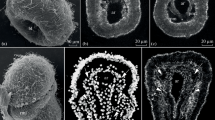Abstract
Various portions of the endoderm between the levels of the first and the 10th somite of 1.5-day-old chick embryos were marked by local application of the vital dye Dil, and the fate of marked cells was analyzed after cultivation of the embryos for 2 days in vitro.
The presumptive area of digestive tract ranging from the posterior pharynx to the jejunum was found to extend bilaterally from the midline of the 1.5-day embryo with a width two or three times as great as the distance between the midline and the lateral edge of the somite. Either side of this area contributed to the same side of the endodermal tube of digestive tract. The anterior and posterior portions generally contributed to the anterior and posterior regions of the digestive tract, respectively, and the cells originating from the portion farther from the midline took the more ventral and posterior position in the digestive tract endoderm. Most of the presumptive areas of the digestive organs in the endoderm of 1.5-day embryo were located in a more anterior position than those in the splanchnic mesoderm.
Similar content being viewed by others
References
Flamme I (1987) Prolonged and simplified in vitro culture of explanted chick embryos. Anat Embryol 176:45–52
Flamme I, Albach K, Muller S, Christ B, Jacob HJ (1991) Two-phase in vitro culture of explanted chick embryos. Anat Rec 229:427–433
Haffen K, Kedinger M, Simon-Assmann P (1987) Mesenchyme-dependent differentiation of epithelial progenitor cells in the gut. J Pediatr Gastroenterol Nutr 6:14–23
Honig MG, Hume RI (1986) Fluorescent carbocyanine dyes allow living neurons of identified origin to be studied in long-term cultures. J Cell Biol 103:171–187
Honig MG, Hume RI (1989) DiI and DiO: versatile fluorescent dyes for neuronal labelling and pathway tracing. Trends Neurosci 12:333–341
Le Douarin N (1964) Étude expérimentale de l'organogenèse du tube digestif et du foie chez l'embryon de Poulet. Bull Biol Fr Belg 98:543–676
Le Douarin N, Bussonnet C, Chaumont F (1968) Étude des capacités de différenciation et du rôle morphogène de l'endoderme pharyngien chez l'embryon d'Oiseau. Ann Embryol Morphogen 1:29–39
Matsushita S (1995) Fate-mapping study of the splanchnopleural mesoderm of the 1.5-day-old chick embryo. Roux's Arch Dev Biol 204:391–398
Mizuno T (1975) Une hypothèse sur l'organogenèse du tractus digestif. C R Soc Biol 169:1096–1098
Mizuno T, Yasugi S (1990) Susceptibility of epithelia to directive influences of mesenchymes during organogenesis: uncoupling of morphogenesis and cytodifferentiation. Cell Differ Dev 31: 151–159
Rawdon BB, Kramer B, Andrew A (1984) The distribution of endocrine cell progenitors in the gut of chick embryos. J Embryol Exp Morphol 82:131–145
Rawles ME (1936) A study in the localization of organ-forming areas in the chick blastoderm of the head-process stage. J Exp Zool 72:271–315
Romanoff AL (1960) The avian embryo. Macmillan, New York
Rosenquist GC (1970) The origin and movement of prelung cells in the chick embryo as determined by radioautographic mapping. J Embryol Exp Morphol 24:497–509
Rosenquist GC (1971a) The location of the pregut endoderm in the chick embryo at the primitive streak stage as determined by radioautographic mapping. Dev Biol 26:323–335
Rosenquist GC (1971b) The origin and movements of the hepatogenic cells in the chick embryo as determined by radioautographic mapping. J Embryol Exp Morphol 25:97–113
Rudnick D (1952) Development of the digestive tube and its derivatives. Ann NY Acad Sci 55:109–116
Sumiya M (1976a) Differentiation of the digestive tract epithelium of the chick embryo cultured in vitro enveloped in a fragment of the vitelline membrane, in the absence of mesenchyme. Roux's Arch Dev Biol 179:1–17
Sumiya M (1976b) Localization of autodifferentiation potencies in the early endoderm of the chick embryo. J Fac Sci Univ Tokyo Sec IV 13:363–381
Yasugi S (1993) Role of epithelial-mesenchymal interactions in differentiation of epithelium of vertebrate digestive organs. Dev Growth Differ 35:1–9
Yasugi S, Mizuno T (1990) Mesenchymal-epithelial interactions in the organogenesis of digestive tract. Zool Sci 7:159–170
Author information
Authors and Affiliations
Rights and permissions
About this article
Cite this article
Matsushita, S. Fate mapping study of the endoderm of the 1.5-day-old chick embryo. Roux's Arch Dev Biol 205, 225–231 (1996). https://doi.org/10.1007/BF00365800
Received:
Accepted:
Issue Date:
DOI: https://doi.org/10.1007/BF00365800




